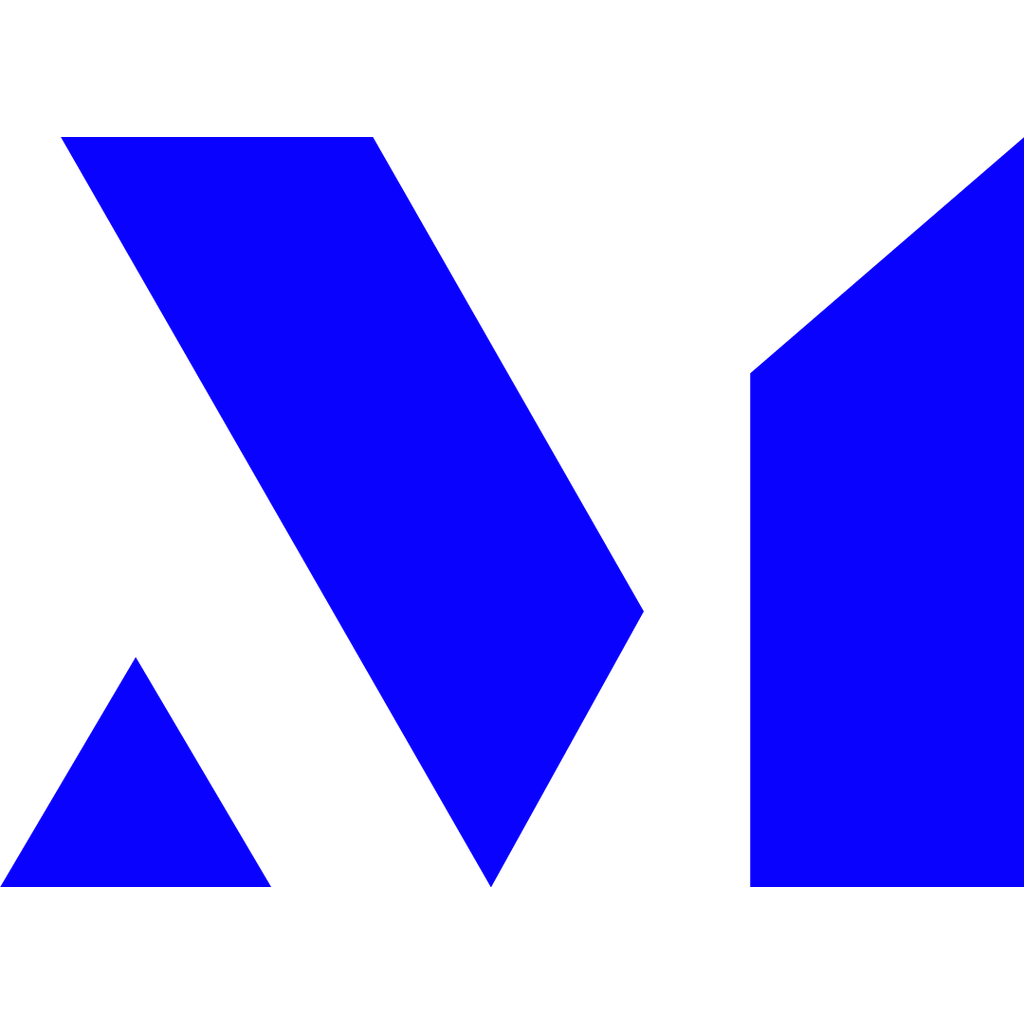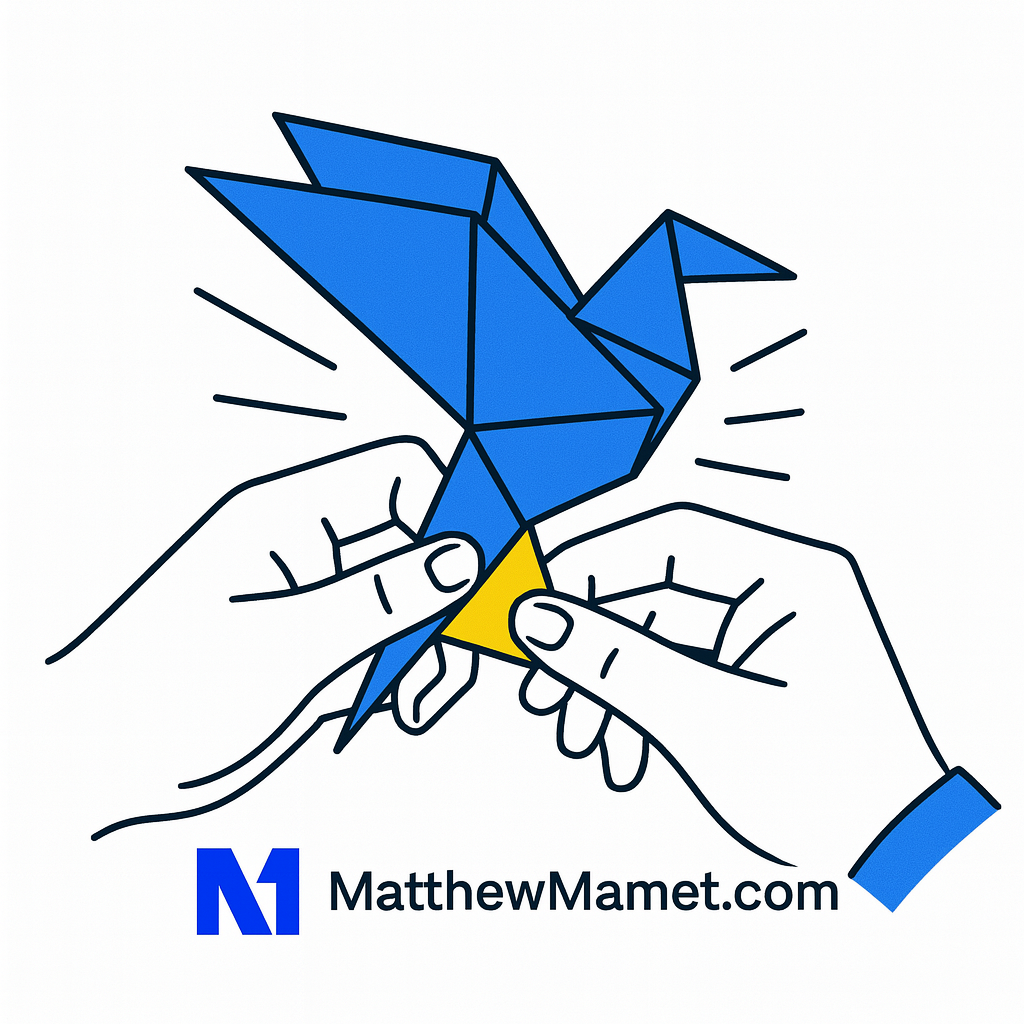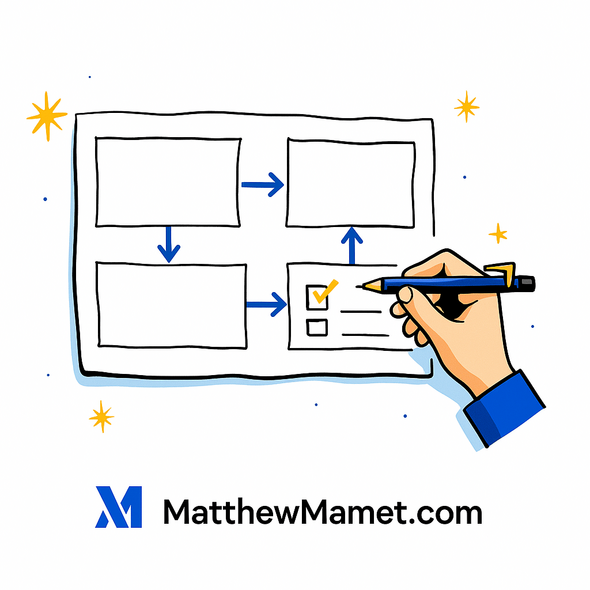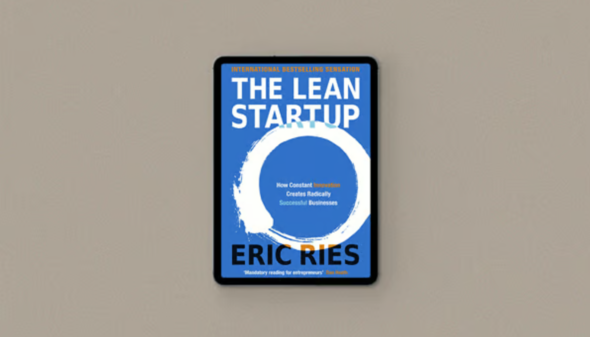Summary:
In the competitive software market, successful product development hinges on effective execution rather than just good ideas. This guide outlines eight essential best practices, including User-Centered Design, Agile methodologies, and Minimum Viable Products, to help software leaders navigate complexity and deliver user-focused value. By integrating these practices, teams can enhance collaboration, leverage data-driven decisions, and streamline development processes. This strategic approach fosters innovation and positions companies to thrive in a dynamic market environment.
Table of Contents
In today's hyper-competitive software market, simply having a good idea isn't enough. The difference between market-leading products and those that fade into obscurity often lies in the execution. For software executives and product leaders, mastering the right methodologies is paramount to navigating complexity, reducing risk, and consistently delivering value that resonates with users. This requires a disciplined, strategic approach grounded in proven frameworks.
This guide moves beyond theory, presenting a curated roundup of eight essential product development best practices. We will dissect each one, from User-Centered Design and Agile methodologies to the strategic use of Minimum Viable Products (MVPs) and CI/CD pipelines. This isn't just a list; it's a strategic playbook designed to refine your approach, empower your teams, and transform your product roadmap into a powerful engine for sustainable growth. To effectively implement this kind of blueprint, you need a strong foundational plan; explore our guide on powerful project outline example templates to structure your initiatives for success from the very beginning.
Inside, you will find actionable insights and real-world examples from industry titans like Netflix and Spotify, complete with tactical steps for implementation. Whether you are a C-suite executive aiming to sharpen your company’s competitive edge or a technical lead transitioning into a product role, these practices provide the structure needed to build, iterate, and win. Let's explore the frameworks that separate the good from the truly great.
Ready to drive more growth & achieve bigger impact?
Leverage my 25+ years of successes and failures to unlock your growth and achieve results you never thought possible.
Get Started1. User-Centered Design (UCD)
User-Centered Design (UCD) is an iterative design philosophy that places the end-user at the absolute core of the product development process. Rather than building a product based on internal assumptions or technological capabilities alone, UCD mandates a deep, empathetic understanding of user needs, behaviors, and motivations. This approach ensures that every design and development decision is a direct response to a real user problem, significantly increasing the likelihood of market adoption and user satisfaction.
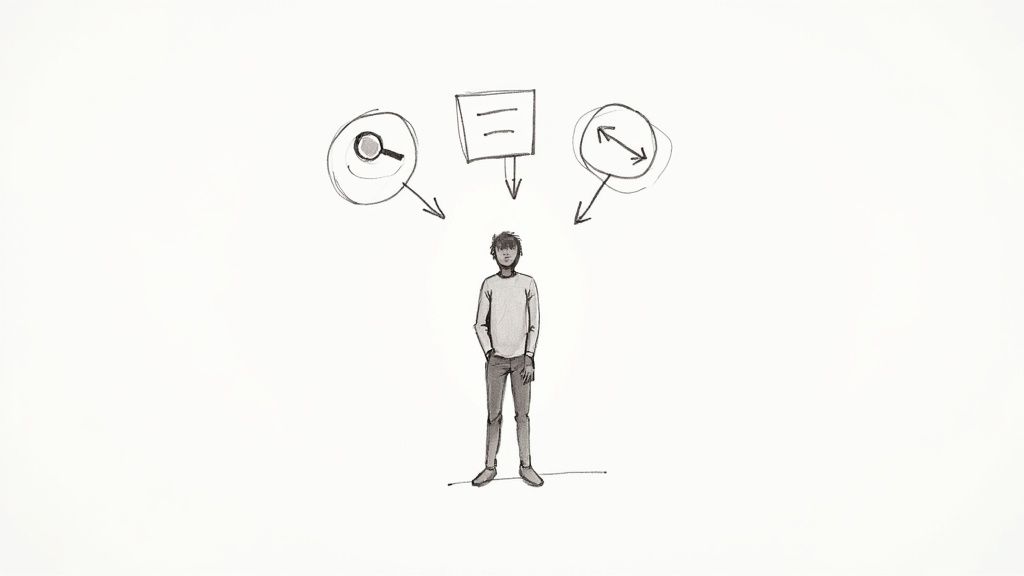
The UCD framework, popularized by pioneers like Don Norman and Jakob Nielsen, involves users throughout the entire lifecycle. It moves beyond simply asking for opinions; it's about observing behavior, testing prototypes, and continuously refining the product based on empirical data and direct feedback.
"You’ve got to start with the customer experience and work back toward the technology, not the other way around." - Steve Jobs
A foundational aspect of this practice involves deeply understanding and addressing specific challenges your users face. A great starting point is learning the different methods for identifying and solving customer pain points to ensure your product delivers tangible value from day one.
How to Implement User-Centered Design
- Start with Research, Not Solutions: Before writing a single line of code, conduct thorough user research. This includes interviews, surveys, and ethnographic studies to build a solid foundation of user understanding.
- Develop User Personas and Journey Maps: Create detailed personas representing your key user segments. Map their end-to-end journey to identify friction points and opportunities for improvement.
- Conduct Regular Usability Testing: Test low-fidelity wireframes, interactive prototypes, and beta versions with real users. Observe where they struggle and succeed, then iterate on the design.
- Establish a Continuous Feedback Loop: Implement mechanisms for users to provide feedback easily within the product. Act on this feedback transparently to build trust and loyalty.
Real-World Example: Airbnb’s early success was heavily tied to UCD. When growth stalled, the team didn’t just add features; they lived with their users. By staying in listed properties, they experienced their hosts' pain points firsthand, leading to a pivotal decision to offer professional photography services. This user-centric insight directly addressed a core user need (trust and quality) and dramatically improved bookings and platform growth.
Ready to drive more growth & achieve bigger impact?
Leverage my 25+ years of successes and failures to unlock your growth and achieve results you never thought possible.
Get Started2. Agile Development Methodology
Agile Development is an iterative and incremental approach to product development that prioritizes flexibility, customer collaboration, and rapid delivery. Instead of a rigid, long-term plan, Agile breaks down large projects into small, manageable development cycles called sprints. This methodology, one of the most vital product development best practices, values individuals and interactions over processes, and working software over comprehensive documentation.
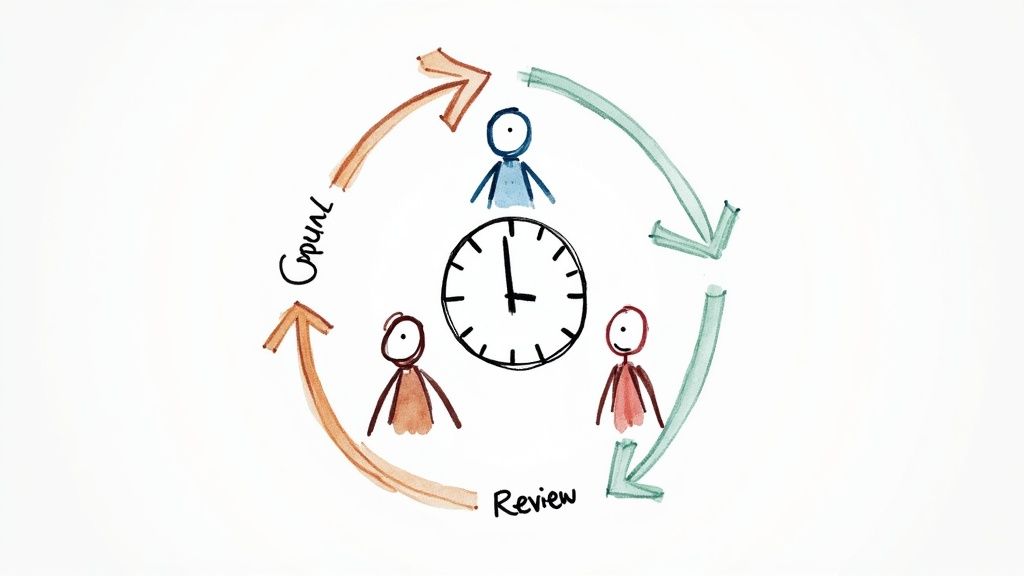
The core idea, outlined in the Agile Manifesto, is to empower teams to respond to change rather than blindly follow a plan. By delivering functional pieces of the product frequently, teams can gather real-world feedback and adapt their priorities accordingly. This continuous loop of building, testing, and learning minimizes risk and ensures the final product aligns with market needs and user expectations.
"The ability to learn faster from customers is the single greatest competitive advantage that a startup has." - Eric Ries, The Lean Startup
Adopting an Agile mindset means shifting from a project-based focus to a product-based one. It encourages cross-functional teams to work together, fostering a culture of shared ownership and continuous improvement. This is essential for navigating the complexities of modern software development and staying ahead in a competitive landscape.
How to Implement Agile Development Methodology
- Start with a Framework: Choose an Agile framework that fits your team's culture, such as Scrum or Kanban. Scrum uses time-boxed sprints, while Kanban focuses on a continuous flow of work.
- Empower Cross-Functional Teams: Build small, self-organizing teams that include all the skills needed to deliver a product increment, from design and development to testing and deployment.
- Prioritize the Backlog: Maintain a product backlog that is continuously prioritized based on business value and user feedback. This ensures the team is always working on the most impactful features.
- Conduct Regular Ceremonies: Implement key Agile meetings like daily stand-ups, sprint planning, sprint reviews, and retrospectives to maintain alignment, track progress, and foster continuous improvement.
Real-World Example: Spotify is a prime example of Agile at scale. They developed the "Spotify Model," organizing their teams into Squads (small, cross-functional teams), Tribes (collections of Squads), Chapters (competency areas), and Guilds (communities of interest). This structure allows them to maintain the agility of a startup while operating at the scale of a global enterprise, enabling rapid and independent feature development and deployment.
Ready to drive more growth & achieve bigger impact?
Leverage my 25+ years of successes and failures to unlock your growth and achieve results you never thought possible.
Get Started3. Minimum Viable Product (MVP)
A Minimum Viable Product (MVP) is a version of a new product that allows a team to collect the maximum amount of validated learning about customers with the least effort. Instead of building a feature-rich, "finished" product, the MVP strategy focuses on launching a core version that solves a single, critical problem for a specific group of early adopters. This approach enables teams to test their fundamental business hypotheses in the real world, mitigating risk and avoiding the costly mistake of building something nobody wants.
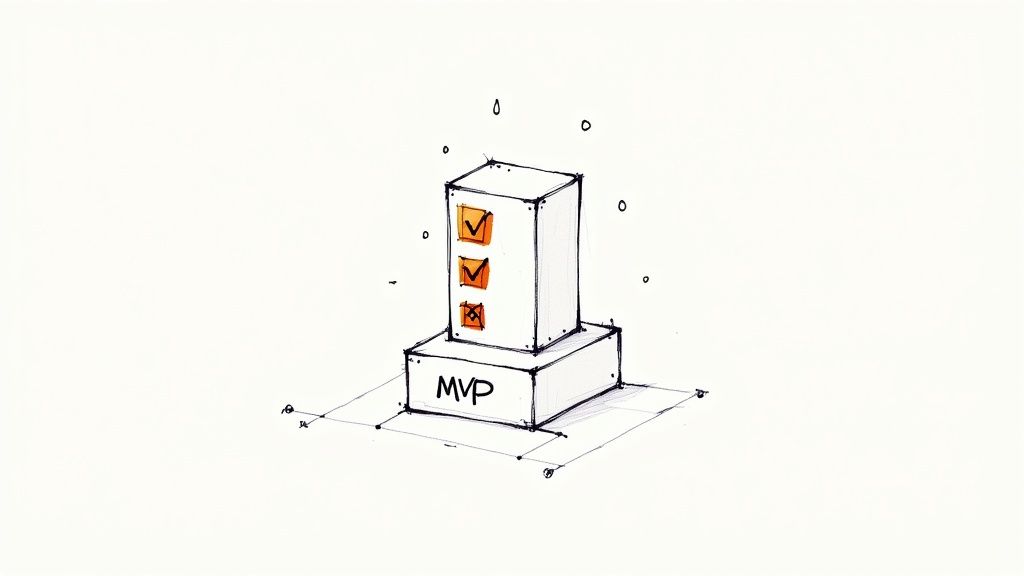
Popularized by Eric Ries in "The Lean Startup," the MVP is the centerpiece of a build-measure-learn feedback loop. It's not about delivering a subpar or incomplete product; it's about being strategic and intentional with resources to validate a core value proposition. The goal is to start the learning process as quickly as possible, using real user data to guide future development.
"The minimum viable product is that version of a new product which allows a team to collect the maximum amount of validated learning about customers with the least effort." - Eric Ries
By releasing an MVP, you are actively engaging in one of the most effective forms of product risk management, as it directly tests market assumptions before significant capital is invested. It transforms product development from a series of internal bets into a scientific process of hypothesis testing.
How to Implement a Minimum Viable Product Strategy
- Define the Core Problem and Hypothesis: Be ruthlessly specific about the one key problem your product solves and for whom. Formulate a clear hypothesis, for example, "We believe early tech adopters will pay for a tool that automates X to achieve Y."
- Prioritize Features Relentlessly: Identify the absolute minimum set of features required to solve that core problem and test your hypothesis. Use frameworks like the MoSCoW method (Must-have, Should-have, Could-have, Won't-have) to focus only on the "Must-haves."
- Set Clear Success Metrics: Before launch, define what success looks like. Key metrics could include user sign-ups, engagement rates, conversion to a paid plan, or positive qualitative feedback.
- Plan for Rapid Iteration: An MVP is a starting point, not the final destination. Have your team and processes ready to quickly analyze feedback and data, then iterate on the product in short, focused cycles.
Real-World Example: Dropbox famously used a "video MVP" before building its full-fledged product. Instead of spending months developing a complex file-syncing application fraught with technical risk, founder Drew Houston created a simple video demonstrating how the product would work. He shared it with a community of tech enthusiasts, and the sign-up list exploded from 5,000 to 75,000 overnight. This low-cost MVP validated the market demand and core value proposition without a single line of production code.
Ready to drive more growth & achieve bigger impact?
Leverage my 25+ years of successes and failures to unlock your growth and achieve results you never thought possible.
Get Started4. Design Thinking Process
The Design Thinking Process is a human-centered, iterative methodology for creative problem-solving and innovation. It provides a structured framework that integrates deep user empathy, expansive ideation, and hands-on experimentation to navigate complex challenges. This approach, popularized by pioneers like Tim Brown and David Kelley of IDEO and the Stanford d.school, focuses on what is desirable from a human point of view, feasible from a technological standpoint, and viable for business success.
This methodology moves beyond traditional problem-solving by encouraging teams to question assumptions and reframe problems in human-centric ways. It’s a collaborative, hands-on process that prioritizes action and learning through making, ensuring that solutions are not just theoretical but grounded in real-world user needs and contexts. The core of this product development best practice lies in its structured yet flexible five-stage model: Empathize, Define, Ideate, Prototype, and Test.
"Design thinking is a human-centered approach to innovation that draws from the designer's toolkit to integrate the needs of people, the possibilities of technology, and the requirements for business success." - Tim Brown, CEO of IDEO
A key element of this process is building a profound understanding of the people you are designing for. This initial empathic phase is critical for uncovering latent needs and insights that fuel truly innovative solutions, ensuring the final product resonates on a deeper level.
Ready to drive more growth & achieve bigger impact?
Leverage my 25+ years of successes and failures to unlock your growth and achieve results you never thought possible.
Get StartedThe following visual breaks down the core iterative loop of the Design Thinking Process into its essential stages.
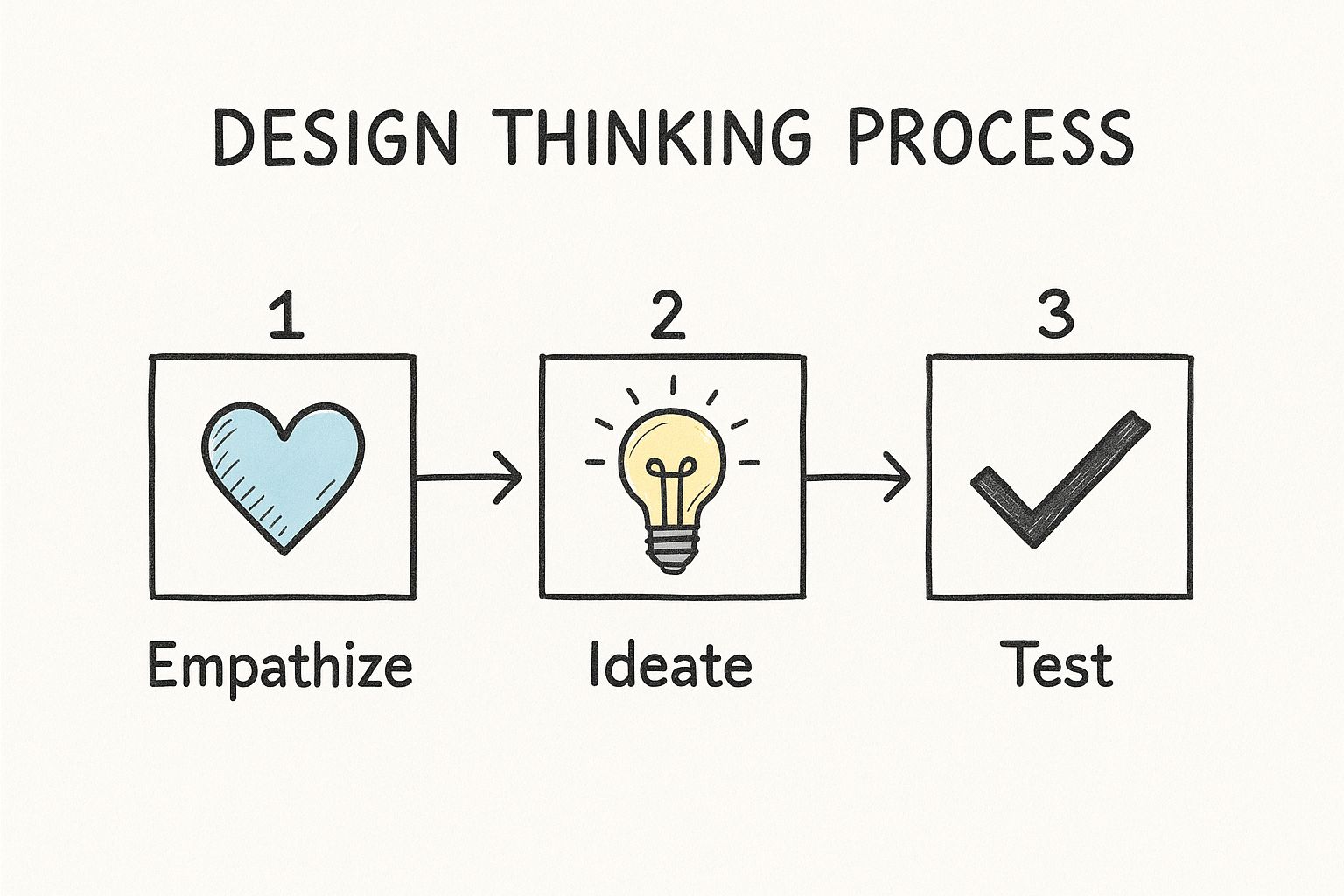
This process flow visualizes the foundational cycle of understanding users (Empathize), generating ideas (Ideate), and validating them with tangible models (Test).
How to Implement the Design Thinking Process
- Start with Deep Empathy: Go beyond surveys. Conduct ethnographic research, immersive user interviews, and observation to truly understand your users' world, their challenges, and their emotional drivers.
- Embrace Expansive Ideation: Use visual tools like whiteboards and sticky notes for brainstorming sessions. Encourage wild ideas and defer judgment to generate a broad range of potential solutions.
- Prototype Quickly and Cheaply: Build low-fidelity prototypes using simple materials like paper, storyboards, or digital wireframing tools. The goal is not perfection but to make ideas tangible for testing.
- Test Assumptions Early and Often: Share your prototypes with real users to test your core assumptions. Embrace failure as a valuable learning opportunity and use the feedback to refine your solution.
Real-World Example: Bank of America’s "Keep the Change" savings program was born from a design thinking initiative. By observing how families managed their finances, an IDEO team noticed that many people struggled to save money but frequently rounded up totals in their checkbooks. This empathic insight led to the creation of a program that automatically rounds up debit card purchases to the nearest dollar and transfers the difference to a savings account. The program was a massive success, attracting millions of customers by solving a real, unspoken user need.
5. Continuous Integration/Continuous Deployment (CI/CD)
Continuous Integration/Continuous Deployment (CI/CD) is a cornerstone of modern software development, representing a set of practices that automates the build, test, and deployment pipeline. Continuous Integration encourages developers to merge their code changes into a central repository frequently, where automated builds and tests are run. Continuous Deployment extends this by automatically deploying all code changes that pass the testing stage to a production environment, making software releases a low-risk, everyday event.
This practice is essential among product development best practices because it dramatically shortens the development lifecycle. Promoted by thought leaders like Martin Fowler and Jez Humble, the CI/CD pipeline ensures that new features, bug fixes, and updates reach users faster and more reliably. It transforms deployment from a high-stress, manual process into a routine, automated workflow, minimizing human error and enabling rapid iteration.
"The key to rapid, reliable, low-risk deployments is to make them boring. The way to make them boring is to do them frequently." - Jez Humble
A core tenet of this approach is creating a seamless and automated path from a developer's machine to the end-user. By automating these stages, teams can focus on building quality features instead of managing complex release logistics. The practice underpins the DevOps culture, fostering collaboration between development and operations teams to deliver value continuously.
Ready to drive more growth & achieve bigger impact?
Leverage my 25+ years of successes and failures to unlock your growth and achieve results you never thought possible.
Get StartedHow to Implement CI/CD
- Start with Comprehensive Automated Testing: Your CI/CD pipeline is only as reliable as your tests. Build a robust suite of unit, integration, and end-to-end tests that must pass before any code proceeds to the next stage.
- Implement Gradual Rollout Strategies: Avoid big-bang releases. Use techniques like blue-green deployments or canary releases to push changes to a small subset of users first, allowing you to monitor for issues before a full rollout.
- Use Feature Flags for Safe Deployments: Decouple deployment from release. Feature flags (or toggles) allow you to deploy code to production while keeping new features hidden until they are ready, enabling safe testing in a live environment.
- Invest in Proper Tooling and Infrastructure: Select the right CI/CD tools (like Jenkins, GitLab CI, or GitHub Actions) that fit your team's workflow and technology stack. Ensure your infrastructure is scalable and resilient enough to handle automated processes.
Real-World Example: Netflix is a prime example of CI/CD mastery. The company’s engineering culture is built around a highly automated pipeline that allows it to deploy thousands of changes to production daily with minimal disruption. Their sophisticated system, Spinnaker, enables developers to push code with confidence, knowing that a series of automated checks and safe deployment strategies will catch potential issues, ensuring a resilient and constantly evolving service for millions of users worldwide.
6. Cross-Functional Team Collaboration
Cross-Functional Team Collaboration is a powerful organizational model where individuals from different departments and disciplines work together as a single, cohesive unit. This approach breaks down traditional operational silos, ensuring that perspectives from engineering, design, marketing, sales, and support are integrated throughout the entire product development process. By fostering this holistic environment, companies can make more informed decisions, accelerate innovation, and build products that are not only technologically sound but also market-ready and customer-centric.
This model, famously championed by organizations like Toyota and later adapted by tech giants like Google and Spotify, moves away from a linear, hand-off-based workflow. Instead, it creates a dynamic where all functions contribute from ideation to launch, preventing late-stage surprises and ensuring alignment with overarching business goals. It's a cornerstone of modern product development best practices.
"Teamwork is the ability to work together toward a common vision. The ability to direct individual accomplishments toward organizational objectives. It is the fuel that allows common people to attain uncommon results." - Andrew Carnegie
Building the right team structure is critical for this model to succeed. For a deeper dive into organizing your talent effectively, explore the various options for your software development team structure to maximize collaborative output and efficiency.
How to Implement Cross-Functional Team Collaboration
- Establish Clear Roles and Shared Goals: Define each member's responsibilities while uniting the team under a single, measurable objective. This clarity prevents overlap and ensures everyone is pulling in the same direction.
- Utilize Collaborative Tools and Spaces: Equip teams with shared digital platforms (like Slack, Jira, or Miro) and physical spaces that encourage spontaneous interaction and transparent communication.
- Hold Regular, Purpose-Driven Meetings: Implement recurring meetings like daily stand-ups, sprint planning, and retrospectives to maintain alignment, solve roadblocks quickly, and continuously improve processes.
- Empower Autonomous Decision-Making: Grant the team the authority to make key decisions within their domain. This autonomy fosters ownership and accelerates the development cycle by reducing reliance on hierarchical approvals.
Real-World Example: Amazon's famous "two-pizza teams" are a prime example of cross-functional collaboration in action. Each small, autonomous team is composed of developers, product managers, and designers who have end-to-end ownership of a specific service or feature. This structure empowers them to operate like a mini-startup within the larger organization, enabling them to innovate, experiment, and deliver value to customers at an incredible pace.
7. Data-Driven Decision Making
Data-Driven Decision Making (DDDM) is a methodology that anchors product development choices in the analysis and interpretation of empirical data rather than relying on intuition, opinion, or anecdotal evidence. This approach involves systematically collecting, analyzing, and acting upon both quantitative and qualitative data to steer product strategy, prioritize features, and enhance user experiences. By doing so, teams can mitigate risks, validate hypotheses, and allocate resources more effectively.
Pioneered by tech giants like Google and Amazon, this practice transforms product management from an art into a science. It ensures that every significant move is backed by evidence, directly connecting development efforts to measurable business outcomes. For truly robust data-driven decision making, a solid foundation of data infrastructure and AI strategies is essential to process and leverage vast amounts of information effectively.
"In God we trust. All others must bring data." - W. Edwards Deming
This practice is fundamental to modern product development best practices because it shifts conversations from "I think" to "the data shows." A crucial first step is to establish which numbers truly matter. To get started, you can explore the different types of key product metrics that high-performing teams use to track success and guide their roadmaps.
Ready to drive more growth & achieve bigger impact?
Leverage my 25+ years of successes and failures to unlock your growth and achieve results you never thought possible.
Get StartedHow to Implement Data-Driven Decision Making
- Define Clear Metrics Before Starting: Before launching a feature or test, define what success looks like with specific, measurable Key Performance Indicators (KPIs). This prevents confirmation bias and ensures objective evaluation.
- Combine Quantitative and Qualitative Data: Use quantitative data (e.g., usage analytics, conversion rates) to understand what is happening and qualitative data (e.g., user interviews, support tickets) to understand why it is happening.
- Ensure Data Quality and Accessibility: Invest in tools and processes that ensure your data is accurate, reliable, and accessible to everyone on the team. A "single source of truth" prevents conflicting analyses and builds trust in the data.
- Foster Data Literacy Across Teams: Promote a culture where every team member, from engineers to marketers, feels comfortable interpreting data and using it to inform their daily work. Host regular training and share insights openly.
Real-World Example: Netflix is a masterclass in data-driven decision making. The company extensively uses A/B testing for everything from its user interface to the artwork used for movie and show thumbnails. By analyzing which images generate the most clicks and engagement for different user segments, Netflix personalizes the experience at a massive scale. This data-backed approach directly increases user engagement and retention, demonstrating the power of using data to optimize every facet of the product experience.
8. Rapid Prototyping and Testing
Rapid Prototyping and Testing is a product development best practice centered on creating fast, inexpensive, and interactive models of a product or feature. Instead of investing heavily in full-scale development based on assumptions, this approach allows teams to visualize concepts, test user flows, and validate hypotheses with real users early and often. It's a method for accelerated learning that significantly reduces the risk of building the wrong product.
Popularized by methodologies like the Google Ventures Design Sprint and the Lean Startup movement, rapid prototyping transforms abstract ideas into tangible experiences. These prototypes can range from simple paper sketches to high-fidelity, interactive mockups. The goal isn't perfection; it's to generate feedback and iterate quickly before a single line of production code is written.
"If a picture is worth 1000 words, a prototype is worth 1000 meetings." - Tom & David Kelley, IDEO
This practice is fundamental to de-risking innovation. By testing a low-cost representation, teams can fail cheaply and learn invaluable lessons that guide the final product toward market fit. A helpful resource for teams looking to master this is the Google Design Sprint Kit, which provides a structured framework for this exact process.
How to Implement Rapid Prototyping and Testing
- Start with Low-Fidelity: Begin with paper prototypes or simple wireframes. This allows you to test core concepts and user flows without getting bogged down in visual details, encouraging honest feedback on functionality.
- Match Fidelity to Your Goal: Use low-fidelity prototypes to test concepts and high-fidelity prototypes (using tools like Figma or Adobe XD) to test usability and visual design. The level of detail should match the questions you need to answer.
- Test with Real Users, Not Colleagues: Internal feedback is biased. Recruit actual target users to interact with your prototype. Observe their behavior, listen to their thoughts, and identify where they encounter friction.
- Embrace a "Throwaway" Mindset: Don't get emotionally attached to your prototypes. Their purpose is to facilitate learning. Be prepared to discard them and start over based on user feedback.
Real-World Example: Before committing to a billion-dollar hardware investment, Google built a crude but functional prototype for Google Glass using a coat hanger, a pico projector, and plexiglass. This low-cost model allowed the team to experience the core concept of augmented reality in a wearable format. This early, tangible testing validated key assumptions and revealed fundamental user experience challenges long before any manufacturing or complex engineering began.
Best Practices Comparison Matrix
| Methodology / Approach | Implementation Complexity 🔄 | Resource Requirements ⚡ | Expected Outcomes 📊 | Ideal Use Cases 💡 | Key Advantages ⭐ |
|---|---|---|---|---|---|
| User-Centered Design (UCD) | High due to continuous research and iterative design 🔄 | High upfront research and user testing costs ⚡ | Better user satisfaction, accessibility, lower failure risk 📊 | Products requiring strong user focus and usability 💡 | High adoption, improved market fit, inclusivity ⭐ |
| Agile Development Methodology | Moderate with sprint cycles and team coordination 🔄 | Requires skilled teams and collaboration tools ⚡ | Faster delivery, adaptability, improved team morale 📊 | Projects needing flexibility and incremental delivery 💡 | Rapid time-to-market, continuous testing ⭐ |
| Minimum Viable Product (MVP) | Low to moderate; focus on core features 🔄 | Low resource use; fast development ⚡ | Early market validation, fast learning cycles 📊 | Startups and new products testing market assumptions 💡 | Fast launch, cost efficiency, risk reduction ⭐ |
| Design Thinking Process | Moderate to high; structured 5-stage iterative process 🔄 | Requires multidisciplinary collaboration ⚡ | Innovative, user-focused solutions balancing feasibility 📊 | Complex problems needing innovation and human insight 💡 | Encourages creativity, collaboration, early testing ⭐ |
| CI/CD | High initial setup and tooling complexity 🔄 | Significant tooling and infrastructure investment ⚡ | Faster releases, reduced risks, higher code quality 📊 | Software teams needing frequent, reliable deployments 💡 | Automated pipeline, rapid bug detection, productivity ⭐ |
| Cross-Functional Team Collaboration | Moderate; coordination across departments 🔄 | Requires diverse skill sets and strong leadership ⚡ | Faster, informed decisions; enhanced innovation 📊 | Organizations breaking down silos for holistic products 💡 | Improved communication, diverse insights, morale ⭐ |
| Data-Driven Decision Making | Moderate to high; data infrastructure and analysis 🔄 | High data collection and analysis capabilities ⚡ | Objective decisions, better product performance 📊 | Products needing KPI focus and validated growth strategies 💡 | Reduces bias, improves performance, measurable success ⭐ |
| Rapid Prototyping and Testing | Moderate; repeated prototype iterations 🔄 | Requires materials and prototyping skills ⚡ | Early flaw detection, faster validation, innovation 📊 | Innovative products needing fast design validations 💡 | Cost-effective risk reduction, faster creativity cycles ⭐ |
From Practice to Performance: Your Next Steps
Navigating the landscape of modern software creation requires more than just a good idea; it demands a disciplined, strategic approach. Throughout this guide, we've explored a powerful collection of product development best practices, moving from high-level concepts to the tactical execution that separates market leaders from the rest. We’ve seen how User-Centered Design (UCD) anchors your efforts in real user needs, preventing the creation of products that are technically sound but practically irrelevant. We’ve unpacked the Agile Development Methodology and the Minimum Viable Product (MVP), two pillars that champion iterative progress and rapid learning over monolithic, high-risk launches.
These frameworks are not isolated islands of excellence. Their true power is unleashed when they are woven together into a cohesive operational fabric. The ideation and empathy stages of the Design Thinking Process flow seamlessly into Rapid Prototyping and Testing, creating a tight feedback loop that validates assumptions early and often. This cycle is then accelerated by a robust Continuous Integration/Continuous Deployment (CI/CD) pipeline, which transforms validated ideas into deployed features with speed and reliability. None of this is possible, however, without the foundational elements of Cross-Functional Team Collaboration and Data-Driven Decision Making. When engineering, design, marketing, and product management operate in synergistic alignment, guided by empirical evidence rather than gut feelings, the entire development lifecycle becomes more efficient, predictable, and impactful.
Ready to drive more growth & achieve bigger impact?
Leverage my 25+ years of successes and failures to unlock your growth and achieve results you never thought possible.
Get StartedTurning Insight into Actionable Strategy
The journey from understanding these product development best practices to mastering them is where true competitive advantage is forged. Adopting these principles is not a one-time project with a clear start and end date; it's a profound cultural and operational shift toward continuous improvement. The most innovative companies don’t just "do Agile" or "use data"; they embody these principles in their daily rituals, their strategic planning, and their leadership philosophy.
So, where do you begin? Avoid the temptation to implement everything at once. A "big bang" transformation can overwhelm teams and lead to confusion. Instead, adopt a more strategic, incremental approach:
- Conduct a Diagnostic: Start by honestly assessing your current processes. Where are the biggest bottlenecks? Are you struggling with slow release cycles? Is user feedback consistently surprising you post-launch? Is team morale low due to siloed communication? Pinpoint the one or two areas causing the most significant friction.
- Select Your Starting Point: Match a best practice to your most pressing problem. If your time-to-market is lagging, focusing on optimizing your CI/CD pipeline could deliver the most immediate value. If your products are failing to gain traction, a renewed commitment to UCD and the Design Thinking process is your logical first step.
- Launch a Pilot Program: Choose a single team or project to pilot the new practice. This creates a controlled environment to learn, adapt the framework to your unique company culture, and build a success story. Document the process, measure the outcomes, and gather feedback from the team.
- Champion the Change: As a leader, your role is pivotal. You must be the chief advocate for this evolution, celebrating the small wins, providing the necessary resources and training, and reinforcing the "why" behind the change. Effective leadership is the catalyst that transforms a checklist of best practices into a living, breathing engine for innovation.
By embracing this path, you are not merely optimizing a workflow; you are building a resilient, adaptive organization capable of navigating market shifts and consistently delivering value to your customers. Committing to the mastery of these product development best practices positions your company not just to compete in today’s demanding landscape, but to define what comes next.
Ready to bridge the gap between knowing these practices and implementing them for measurable results? Executive coach Matthew Mamet specializes in helping software leaders and their teams embed these elite strategies into their core operations, transforming development processes into a sustainable competitive advantage. Learn how personalized guidance can accelerate your journey at Matthew Mamet.
Ready to drive more growth & achieve bigger impact?
Leverage my 25+ years of successes and failures to unlock your growth and achieve results you never thought possible.
Get Started